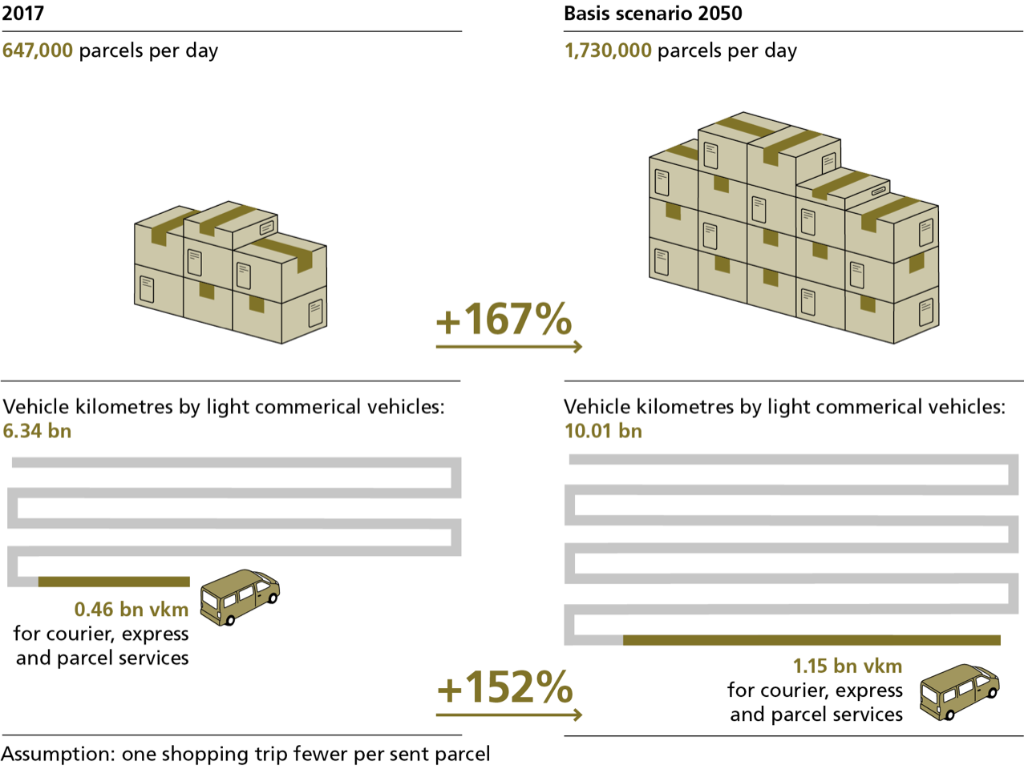Trains, trucks and vans move hundreds of millions of tonnes of goods in Switzerland every year. This traffic will increase as economic output grows. However, this is not the case for the transport of fuel by rail; here volumes will decrease, because an increase in the use of electric cars and more widespread climate-friendly heating systems reduces the need for fuel imports. The rise in online retail results in more trips made by delivery vans.
Freight transport services are measured in tonne-kilometres. For example, two tonnes transported over a distance of 10 km corresponds to a value of 20 tonne-kilometres (tkm). The same value is achieved when one tonne is transported over a distance of 20km.
Freight transport increases with economic output
Over the next 30 years, transport services will expand in all scenarios. This is primarily because both the population and the economy grow and so more goods and commodities are consumed. Thus transport services increase most markedly in the Individualised Society scenario, which is characterised by high material consumption. Compared to the Basis and Business-as-Usual scenarios, there is a new trend in freight transport in the Sustainable Society scenario, with fewer imports and exports and more domestic traffic. This is because, in this sustainable scenario, local production increases and so more goods are transported within Switzerland.
Today the majority of transit traffic is already by rail. This share of rail will continue to rise and will exceed 80 per cent as early as 2025. Compared to transit traffic, only 20 per cent of goods in domestic, import and export traffic are transported by rail. This difference can be explained by the fact that Switzerland's good rail infrastructure is better suited to long-distance transit traffic than the roads.
Less fuel transport by rail
The share of road and rail in transport services, known as modal split, differs across the various scenarios for 2050. In the Business-as-Usual scenario, the share of rail goes down. This is mainly because less fossil energy is required. Since petroleum is the commodity that is transported most by rail, the decrease in fuel transport leads to a decrease in rail transport.
The volume of fuel transported also falls in the Basis and Sustainable Society scenarios. However, the share of rail in the modal split does not drop so markedly, since political measures such as an increase in the heavy goods vehicle charge HGVC make rail transport cheaper than road transport.
In other freight categories, for example waste and mixed freight, in the Basis and Sustainable Society scenarios rail forms a greater part of the modal split. An important prerequisite for this development is an increased bundling of goods at terminals so they can be transferred efficiently from road to rail.
More light commercial vehicles on the road
Compared to heavy goods vehicles, light commercial vehicles (LCV) form a small proportion of transport services in tonne-kilometres as they transport smaller loads or none at all. However, they are accountable for a large share of the distance travelled in vehicle-kilometres, i.e. they form a considerable proportion of road traffic.
There are several reasons for this. Firstly, tradespeople and other small and medium-sized businesses use such vehicles, and as economic output increases, so does their use. Secondly, the growth of online shopping pushes up the proportion of trips made by courier, express and parcel services. Among LCVs, this type of traffic already accounts for about seven per cent of the vehicle-kilometres travelled.
Over the next 30 years, there will be ever increasing numbers of LCVs on the roads. This means that in the Basis scenario, although the development of passenger traffic stagnates, the Swiss road network comes under greater pressure because LCVs account for increasing distances travelled.
Effects of e-commerce
In Transport Outlook 2050, the assumption was made that one parcel shipment corresponds to one shopping trip not made. An increase in the number of parcels was determined for each scenario based on the reduction of shopping trips. Delivery traffic on the roads increases in proportion to the decrease in shopping trips. This means, for example, that ten per cent more parcels result in nine per cent more courier, express and parcel services trips.

This growth in LCV trips for courier, express and parcel deliveries is much larger than the growth in other LCV trips, for instance for services. This is particularly the case in the Individualised Society and Sustainable Society scenarios, in which a strong increase in online trade is expected.
The traffic loads per segment of the road network are available as a map on the federal geoportal.

